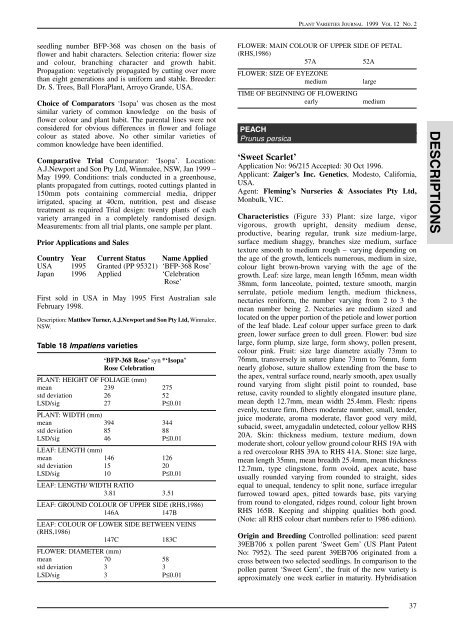56. Volume 12- Number 2 - IP Australia
56. Volume 12- Number 2 - IP Australia
56. Volume 12- Number 2 - IP Australia
You also want an ePaper? Increase the reach of your titles
YUMPU automatically turns print PDFs into web optimized ePapers that Google loves.
DESCR<strong>IP</strong>TIONS<br />
PLANT VARIETIES JOURNAL 1999 VOL <strong>12</strong> NO. 2<br />
seedling number BFP-368 was chosen on the basis of<br />
flower and habit characters. Selection criteria: flower size<br />
and colour, branching character and growth habit.<br />
Propagation: vegetatively propagated by cutting over more<br />
than eight generations and is uniform and stable. Breeder:<br />
Dr. S. Trees, Ball FloraPlant, Arroyo Grande, USA.<br />
Choice of Comparators ‘Isopa’ was chosen as the most<br />
similar variety of common knowledge on the basis of<br />
flower colour and plant habit. The parental lines were not<br />
considered for obvious differences in flower and foliage<br />
colour as stated above. No other similar varieties of<br />
common knowledge have been identified.<br />
Comparative Trial Comparator: ‘Isopa’. Location:<br />
A.J.Newport and Son Pty Ltd, Winmalee, NSW, Jan 1999 –<br />
May 1999. Conditions: trials conducted in a greenhouse,<br />
plants propagated from cuttings, rooted cuttings planted in<br />
150mm pots containing commercial media, dripper<br />
irrigated, spacing at 40cm, nutrition, pest and disease<br />
treatment as required Trial design: twenty plants of each<br />
variety arranged in a completely randomised design.<br />
Measurements: from all trial plants, one sample per plant.<br />
Prior Applications and Sales<br />
Country Year Current Status Name Applied<br />
USA 1995 Granted (PP 95321) ‘BFP-368 Rose’<br />
Japan 1996 Applied ‘Celebration<br />
Rose’<br />
First sold in USA in May 1995 First <strong>Australia</strong>n sale<br />
February 1998.<br />
Description: Matthew Turner, A.J.Newport and Son Pty Ltd, Winmalee,<br />
NSW.<br />
Table 18 Impatiens varieties<br />
‘BFP-368 Rose’ syn *‘Isopa’<br />
Rose Celebration<br />
PLANT: HEIGHT OF FOLIAGE (mm)<br />
mean 239 275<br />
std deviation 26 52<br />
LSD/sig 27 P≤0.01<br />
PLANT: WIDTH (mm)<br />
mean 394 344<br />
std deviation 85 88<br />
LSD/sig 46 P≤0.01<br />
LEAF: LENGTH (mm)<br />
mean 146 <strong>12</strong>6<br />
std deviation 15 20<br />
LSD/sig 10 P≤0.01<br />
LEAF: LENGTH/ WIDTH RATIO<br />
3.81 3.51<br />
LEAF: GROUND COLOUR OF UPPER SIDE (RHS,1986)<br />
146A<br />
147B<br />
LEAF: COLOUR OF LOWER SIDE BETWEEN VEINS<br />
(RHS,1986)<br />
147C<br />
183C<br />
FLOWER: DIAMETER (mm)<br />
mean 70 58<br />
std deviation 3 3<br />
LSD/sig 3 P≤0.01<br />
FLOWER: MAIN COLOUR OF UPPER SIDE OF PETAL<br />
(RHS,1986)<br />
57A<br />
52A<br />
FLOWER: SIZE OF EYEZONE<br />
medium<br />
TIME OF BEGINNING OF FLOWERING<br />
early<br />
PEACH<br />
Prunus persica<br />
large<br />
medium<br />
‘Sweet Scarlet’<br />
Application No: 96/215 Accepted: 30 Oct 1996.<br />
Applicant: Zaiger’s Inc. Genetics, Modesto, California,<br />
USA.<br />
Agent: Fleming’s Nurseries & Associates Pty Ltd,<br />
Monbulk, VIC.<br />
Characteristics (Figure 33) Plant: size large, vigor<br />
vigorous, growth upright, density medium dense,<br />
productive, bearing regular, trunk size medium-large,<br />
surface medium shaggy, branches size medium, surface<br />
texture smooth to medium rough – varying depending on<br />
the age of the growth, lenticels numerous, medium in size,<br />
colour light brown-brown varying with the age of the<br />
growth. Leaf: size large, mean length 165mm, mean width<br />
38mm, form lanceolate, pointed, texture smooth, margin<br />
serrulate, petiole medium length, medium thickness,<br />
nectaries reniform, the number varying from 2 to 3 the<br />
mean number being 2. Nectaries are medium sized and<br />
located on the upper portion of the petiole and lower portion<br />
of the leaf blade. Leaf colour upper surface green to dark<br />
green, lower surface green to dull green. Flower: bud size<br />
large, form plump, size large, form showy, pollen present,<br />
colour pink. Fruit: size large diametre axially 73mm to<br />
76mm, transversely in suture plane 73mm to 76mm, form<br />
nearly globose, suture shallow extending from the base to<br />
the apex, ventral surface round, nearly smooth, apex usually<br />
round varying from slight pistil point to rounded, base<br />
retuse, cavity rounded to slightly elongated insuture plane,<br />
mean depth <strong>12</strong>.7mm, mean width 25.4mm. Flesh: ripens<br />
evenly, texture firm, fibers moderate number, small, tender,<br />
juice moderate, aroma moderate, flavor good very mild,<br />
subacid, sweet, amygadalin undetected, colour yellow RHS<br />
20A. Skin: thickness medium, texture medium, down<br />
moderate short, colour yellow ground colour RHS 19A with<br />
a red overcolour RHS 39A to RHS 41A. Stone: size large,<br />
mean length 35mm, mean breadth 25.4mm, mean thickness<br />
<strong>12</strong>.7mm, type clingstone, form ovoid, apex acute, base<br />
usually rounded varying from rounded to straight, sides<br />
equal to unequal, tendency to split none, surface irregular<br />
furrowed toward apex, pitted towards base, pits varying<br />
from round to elongated, ridges round, colour light brown<br />
RHS 165B. Keeping and shipping qualities both good.<br />
(Note: all RHS colour chart numbers refer to 1986 edition).<br />
Origin and Breeding Controlled pollination: seed parent<br />
39EB706 x pollen parent ‘Sweet Gem’ (US Plant Patent<br />
No: 7952). The seed parent 39EB706 originated from a<br />
cross between two selected seedlings. In comparison to the<br />
pollen parent ‘Sweet Gem’, the fruit of the new variety is<br />
approximately one week earlier in maturity. Hybridisation<br />
37

















